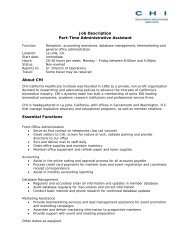California Biomedical Industry - California Healthcare Institute
California Biomedical Industry - California Healthcare Institute
California Biomedical Industry - California Healthcare Institute
You also want an ePaper? Increase the reach of your titles
YUMPU automatically turns print PDFs into web optimized ePapers that Google loves.
Assembly Bill 158 to require theDepartment of Health Care Services(DHCS) to apply for a federal waiverto expand Medi-Cal eligibility forindividuals with chronic hepatitisB. AB 158 did not make it throughthe legislative process due to costsassociated with the bill. In 2009, Maintroduced a resolution declaring May2009 as Hepatitis B Awareness Monthin <strong>California</strong>. The resolution supportscollaborating with all interested partiesto raise public awareness about HBV.It also supports the development ofa comprehensive, statewide HBVprevention and treatment plan. So saidthat “profiling” by physicians in the caseof Asian and Asian-American patientscould save lives. “In a lot of cities in<strong>California</strong>, more than 50 percent of theresidents are Asian,” So said. “Doctorspracticing in those cities everyday missopportunities to save a life.” He addedthat physicians may automatically checkcholesterol, blood sugar, blood pressure,weight, and mass. “For Asian patients,they should add a hepatitis test.”So is acting globally as well as locally.As the founder and executive secretaryof the Asia and Pacific Alliance toEliminate Viral Hepatitis, he is buildinga public private partnership to eliminatethe transmission of viral hepatitisand to increase access to anti-viraltreatment. Using seed money from theClinton Global Initiative, the coalitionhelped fund a WHO epidemiologist tobe stationed in China to oversee theprogram.“That action alone doubled the WHOstaff committed to hepatitis,” So said.“One in 12 people in the world haschronic hepatitis, and WHO had onlyone full-time employee dedicated to thedisease.”The China project that So workedwith provided catch-up vaccinationsfor children. The program vaccinatedmore than 600,000 youngsters under16 years old. Moreover, through theprogram the group was able to educatethe youth about HBV so that they coulddispel some myths and, perhaps, lessenthe stigma within their own homesand villages. The program was carriedout in a remote, sparsely populatedprovince of China, where 50 percent ofthe residents are Tibetans and Muslims,making it a diverse and potentially morecomplex region in which to implement apublic health program.“The idea was that if we could conduct asuccessful program there, China shouldbe able to implement an immunizationprogram across the whole country.”Indeed, in June 2009 the ChineseMinistry of Health announced a catchupprogram to protect another 85million children. The CDC estimatesthat less than 1 percent of childrenunder five are infected with HBV ascompared to 10 percent a decade ago.In his work with the <strong>Institute</strong> ofMedicine (IOM), So helped author arecent report, “Hepatitis and LiverCancer: A National Strategy forPrevention and Control of Hepatitis Band C.” Through the report, the IOMrecommends increased knowledgeand awareness about chronic viralhepatitis among healthcare providers,social service providers, and the public;improved surveillance for hepatitis Band hepatitis C; and better integrationof viral hepatitis services.For a transplant surgeon, success iswatching a patient recover and thrive.For Dr. Samuel So, success would beeliminating HBV as a cause of livercirrhosis, cancer, and failure altogether.38 | <strong>California</strong> <strong>Biomedical</strong> <strong>Industry</strong> 2011 Report






